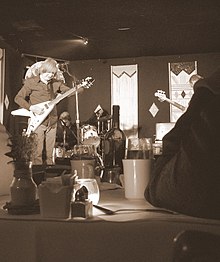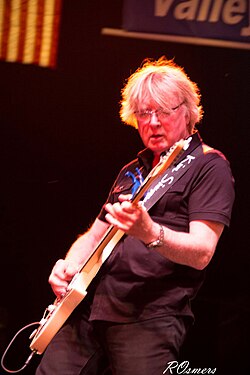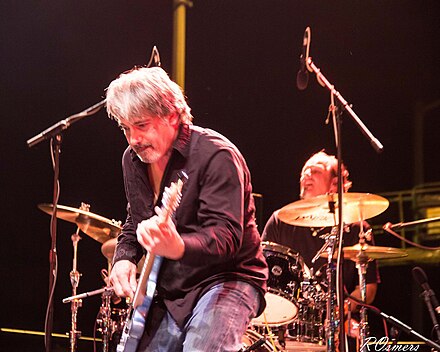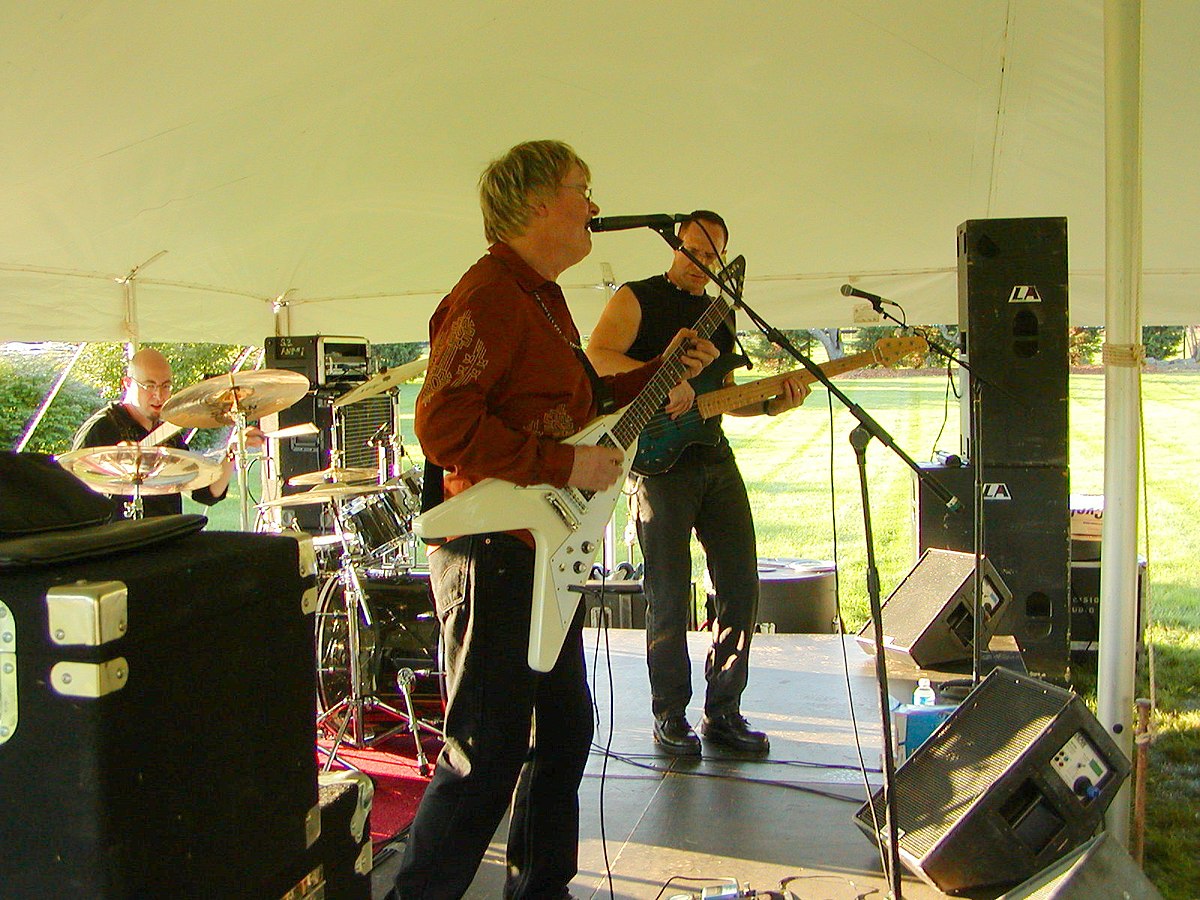
Savoy Brown were a British blues rock band from London. Formed on February 24, 1965, the group was centred around guitarist and vocalist Kim Simmonds, who was originally joined by lead vocalist Brice Portius, bassist Ray Chappell, keyboardist Trevor Jeavons, harmonica player John O'Leary and drummer Leo Mannings. The band's final line-up included Simmonds on guitar and lead vocals along with bassist Pat DeSalvo and drummer Garnet Grimm, both of whom joined in 2009.
History
1965–1970
Kim Simmonds formed Savoy Brown in October 1965 with vocalist Brice Portius, bassist Ray Chappell, drummer Leo Mannings, keyboardist Trevor Jeavons and harmonica player John O'Leary. Shortly after the band's formation, Jeavons was replaced by Bob Hall. In 1966, the group released their first single, "I Tried". Early the next year, Martin Stone of the Action joined as a second guitarist, and a few months later O'Leary left after a dispute with manager Harry Simmonds. The remaining members recorded the group's debut album Shake Down, which was released in September 1967.

Shortly after the release of Shake Down, the band went through a series of personnel changes in quick succession. First, Portius was replaced by Chris Youlden; shortly thereafter, Stone and Chappell also left, with the bassist replaced by Fleetwood Mac founding member Bob Brunning; finally, Mannings was replaced by Hughie Flint (formerly of John Mayall & the Bluesbreakers), while guitarist "Lonesome" Dave Peverett also joined in place of the departed Stone. After recording one single, "Taste and Try, Before You Buy", Brunning and Flint were both fired and replaced in the new year by Rivers Jobe (formerly of Anon) and Bill Bruford, respectively. Bruford lasted only three shows, however, before he was dismissed for "fiddling around with the rhythm".
Bruford was replaced by Roger Earl. The new lineup released "Walking by Myself" in March 1968, followed by the band's second album Getting to the Point a few months later. In November, Jobe was fired and briefly replaced by a returning Bob Brunning; however, he did not want to commit full-time, and was replaced the next month by Tony "Tone" Stevens. The new lineup recorded Blue Matter and A Step Further in 1969, the latter of which marked the final studio contribution of Bob Hall – Simmonds and Youlden shared piano duties on the next album, Raw Sienna. In May 1970, shortly after its release, Youlden left Savoy Brown and Peverett took over lead vocals. The remaining four-piece released Looking In, before Peverett, Stevens and Earl all quit in December 1970; forming Foghat the next month.
1970–1976
Simmonds had reformed Savoy Brown by the end of 1970 with new vocalist Pete Scott, former Blodwyn Pig bassist Andy Pyle and drummer Ron Berg, and former Chicken Shack keyboardist Paul Raymond. In May 1971, after an American tour, Scott was replaced by Dave Walker of the Idle Race, while Pyle and Berg made way for Andy Silvester and Dave Bidwell, respectively, both former bandmates of Raymond in Chicken Shack. The new lineup released Street Corner Talking and Hellbound Train, before Silvester left in June 1972 for "personal reasons" and Pyle returned.

After recording Lion's Share, Walker left Savoy Brown in September 1972 to join Fleetwood Mac. He was replaced by Jackie Lynton. Partway through the recording of their next album Jack the Toad, Bidwell was also replaced by the returning Ron Berg. This lineup completed the album's recording, and its subsequent promotional tour, before Simmonds decided to disband the group again. He rebuilt the group with Hemlock members Miller Anderson (lead vocals, rhythm guitar), Jim Leverton (bass, backing vocals) and Eric Dillon (drums), before former Chicken Shack frontman Stan Webb joined on guitar in January 1974 upon the breakup of his group. The new lineup released Boogie Brothers in April and toured until July, before splitting up and leaving Simmonds to rebuild the band yet again.
By late 1974, Simmonds had brought back keyboardist/guitarist Paul Raymond and drummer Dave Bidwell, as well as adding new lead vocalist Dave Tedstone. This lineup toured the UK and Germany in early 1975, before Tedstone was dismissed and not replaced – Simmonds took over on lead vocals for the first time in the band's history. Bidwell left for a second time during the recording of Wire Fire and was replaced for the rest of the sessions by Tom Farnell; the album was released in October and a tour followed until December, after which Rae was also replaced by Ian Ellis. Skin 'n' Bone followed in April 1976, after which Raymond left in July to join UFO. After Raymond's departure, with the band reduced to a trio, Simmonds decided to take a break and placed Savoy Brown on hiatus.
1978–1992
In early 1978, Savoy Brown returned with Kim Simmonds, Ian Ellis and Tom Farnell joined on tour by an unknown keyboardist; however, the new member was dismissed before the band recorded its next album Savage Return, which credited only the trio. Following the album's release and promotional tour, Simmons relocated to the United States in 1978; he toured during 1979 and 1980 with a lineup including drummer/vocalist Richie Carmichael and a bassist known only as "D.C."(Don Cook), before introducing a new lineup of vocalist Ralph Morman (formerly of the Joe Perry Project), guitarist Barry Paul, drummer Keith Boyce (both formerly of Heavy Metal Kids), and bassist John Humphrey in the summer of 1980. This incarnation issued Rock 'n' Roll Warrior and Greatest Hits Live in 1981, before breaking up at the end of the year.

Savoy Brown was inactive for around two years, before returning in late 1983 with a lineup of Simmonds, vocalist/guitarist Andrew Gerome, bassist Stutz Bearcat and drummer Tommy Amato. The group continued touring during 1984, and was briefly renamed the Kim Simmonds Band. In 1985, Savoy Brown signed with Relix Records and introduced a new incarnation featuring vocalist/harmonica player Speedo Jones and bassist Chris Romanelli. Slow Train, a collection of acoustic recordings, was released in September 1986, shortly after which Simmonds introduced a new lineup with vocalist Jimmy Kunes, bassist Jim Dagnesi and drummer Al Macomber; early the next year, Kunes was replaced by a returning Dave Walker and Shmutza-Hideous joined on percussion (keyboards were handled by various guest performers).
Make Me Sweat was released in January 1988. Walker, Dagnesi and Macomber all remained for Kings of Boogie, issued in March 1989. For the album's tour, Simmonds and Walker were joined by bassist Lou Kaplan, drummer Pete Mendillo and keyboardist Rick Jewett, all members of roots rock band Mad Jack. Kaplan and Mendillo left in 1990 and were replaced by Loren Kraft and Steve Behrendt, respectively, while Jeff Adams joined on guitar. Walker left for a second time in September 1991. He was replaced by Pete McMahon and Phil McCormack. Around the same time, Andy Ramirez and Joe Pierleoni took over from Kraft and Behrendt.
1992–2022
Following the release of Let It Ride in 1992, Simmonds, McMahon, Ramirez and Pierleoni toured through to 1993. Jim Heyl and Dave Olson replaced Ramirez and Pierleoni for the 1994 album Bring It Home. During the second half of the 1990s, Savoy Brown was centred around Simmonds and bassist Nathaniel Peterson, both of whom shared lead vocal duties. The group went through a succession of drummers – first Al Cash, followed by T. Xiques and later Tom Compton. Following the album's release, Simmonds enlisted second guitarist David Malachowski (formerly of Shania Twain's band), bassist Gerry Sorrentino (formerly of Shemekia Copeland's band) and drummer Dennis Cotton (known for his work with Duke Robillard).
With Malachowski, Sorrentino and Cotton, Savoy Brown released studio album Strange Dreams in 2003 and live collection You Should Have Been There! in 2004. Malachowski left the band in 2005. Cotton followed later in the year and was replaced by Mario Staiano. This new trio issued Steel in 2007. In August 2009, Sorrentino was forced to leave the group due to illness, with Pat DeSalvo taking his place. Later in the year, Staiano was also replaced by Garnet Grimm, and Joe Whiting joined on lead vocals and saxophone. Voodoo Moon was released in 2011. Whiting left in late 2012. Simmonds returned to performing lead vocals, and since 2014 the group has released a slew of studio and live albums. Kim Simmonds died on 13 December 2022; the band disbanded shortly after his death.
Personnel
Last lineup
| Image | Name | Years active | Instruments | Release contributions |
|---|---|---|---|---|

|
Kim Simmonds | 1965–2022 (until his death) |
|
all Savoy Brown releases |

|
Pat DeSalvo | 2009–2022 |
|
all Savoy Brown releases from Voodoo Moon (2011) onwards |

|
Garnet Grimm | drums |
Past members
| Image | Name | Years active | Instruments | Release contributions |
|---|---|---|---|---|
| Leo Manning | 1965–1967 | drums |
| |
| Ray Chappell | 1965–1967 (died 2019) | bass guitar | ||
| Brice Portius | 1965–1967 | lead vocals | ||
| John O'Leary | 1965–1967 (died 2024) | harmonica | "I Tried" (1966) | |
| Trevor Jeavons | 1965 | keyboards | none | |
| Bob Hall | 1965–1970 (part-time: 1969–1970) | all Savoy Brown releases from "I Tried" (1966) to A Step Further (1969) | ||
| Martin Stone | 1967 (died 2016) | rhythm and lead guitars | Shake Down (1967) | |
| Chris Youlden | 1967–1970 |
|
| |
| Bob Brunning |
|
bass guitar | "Taste and Try, Before You Buy" (1967) | |
| Hughie Flint | 1967 | drums | ||

|
"Lonesome" Dave Peverett |
|
|
|
| Rivers Jobe | 1968 (died 1979) | bass guitar |
| |

|
Bill Bruford | 1968 | drums | none |

|
Roger Earl | 1968–1970 |
|
|

|
Tony "Tone" Stevens |
|
| |

|
Paul Raymond |
|
|
|
| Andy Pyle |
|
bass guitar |
| |
| Ron Berg | drums | Jack the Toad (1973) – four tracks | ||
| Pete Scott | 1970–1971 | lead vocals | none | |
| Dave Bidwell |
|
|
| |

|
Dave Walker |
|
lead vocals |
|
| Andy Silvester | 1971–1972 | bass guitar |
| |
| Jackie Lynton | 1972–1973 | lead vocals |
| |

|
Miller Anderson | 1973–1974 |
|
Boogie Brothers (1974) |

|
Jim Leverton |
| ||
| Eric Dillon | drums | |||

|
Stan Webb | 1974 |
| |
| Andy Rae | 1974–1975 |
|
| |
| Tom Farnell | 1975–1978 |
|
| |
| Ian Ellis |
|
| ||
| Richie Carmichael | 1979–1980 |
|
none | |
| Don "D.C." Cook | bass guitar | |||
| Ralph Morman | 1980–1981 (died 2014) | lead vocals |
| |
| Barry Paul | 1980–1981 (died 2019) |
| ||
| John Humphrey | 1980–1981 |
| ||
| Keith Boyce | drums | |||
| Andy Gerome | 1983–1984 |
|
none | |
| Stutz Bearcat | bass guitar | |||
| Tommy Amato | drums | |||
| Speedo Jones | 1985–1986 |
|
Slow Train (1986) | |
| Chris Romanelli | bass guitar | |||
| Jim Dagnesi | 1986–1989 |
| ||
| Al Macomber |
| |||
| Shmutza-Hideous | 1986–1988 | percussion | Make Me Sweat (1988) | |
| Jimmy Kunes | 1986–1987 | lead vocals | none | |
| Rick Jewett | 1989–1992 |
|
| |
| Pete Mendillo | 1989–1991 (Died) | drums | Live and Kickin' (1990) | |
| Lou Kaplan | 1989–1990 | bass guitar | ||
| Jeff Adams | 1990–1991 | rhythm guitar | none | |
| Loren Kraft | bass guitar | |||
| Steve Behrendt | drums | |||
| Pete McMahon | 1991–1994 |
|
| |
| Andy Ramirez | 1991–1993 |
|
Let It Ride (1992) | |
| Joe Pierleoni | drums | |||
| Phil McCormack | 1991–1992 | lead vocals | Let It Ride (1992) – two tracks only | |
| Jim Heyl | 1993–1994 | bass guitar | Bring It Home (1994) | |
| Dave Olson | 1993–1994 (died 2016) | drums | ||
| Nathaniel Peterson | 1994–1999 |
|
| |
| Al Kash | 1994–1997 | drums | Train to Nowhere (2010) | |
| T. Xiques | 1997–1998 | Train to Nowhere (2010) – three tracks | ||
| Tom Compton | 1998–1999 | The Blues Keep Holding Me On (1999) | ||

|
Gerry Sorrentino | 1999–2009 |
|
|

|
Dennis Cotton | 1999–2005 |
| |

|
David Malachowski | 1999–2005 (died 2022) |
|
|
| Mario Staiano | 2005–2009 |
|
Steel (2007) – three tracks | |
| Joe Whiting | 2009–2012 |
|
|
Timeline

Lineups
| Period | Members | Releases |
|---|---|---|
| February 24 – December 1965 (as the Savoy Brown Blues Band) |
|
none |
| December 1965 – February 1967 (as the Savoy Brown Blues Band) |
|
|
| February – June 1967 (as the Savoy Brown Blues Band) |
|
none |
| June – September 1967 (as the Savoy Brown Blues Band) |
|
|
| September – October 1967 (as the Savoy Brown Blues Band) |
|
none |
| October 1967 (as the Savoy Brown Blues Band) |
| |
| October 1967 (as the Savoy Brown Blues Band) |
| |
| October – December 1967 (as the Savoy Brown Blues Band) |
|
|
| January 1968 (as the Savoy Brown Blues Band) |
|
none |
| January – November 1968 |
|
|
| November – December 1968 |
|
none |
| December 1968 – May 1970 |
|
|
| May – June 1970 |
|
none |
| June – December 1970 |
|
|
| December 1970 – May 1971 |
|
none |
| May 1971 – June 1972 |
|
|
| June – September 1972 |
|
|
| September – late 1972 |
|
|
| Late 1972 – late 1973 |
|
|
| Late 1973 – January 1974 |
|
none |
| January – summer 1974 |
|
|
| Late 1974 – February 1975 |
|
none |
| February – summer 1975 |
|
|
| Summer – December 1975 |
|
|
| December 1975 – July 1976 |
|
|
| Band on hiatus July 1976 – early 1978 | ||
| Early – late 1978 |
|
|
| Early 1979 – summer 1980 |
|
none |
| Summer 1980 – late 1981 |
|
|
| Band inactive late 1981 – late 1983 | ||
| Late 1983 – late 1984 (as the Kim Simmonds Band during 1984) |
|
none |
| Band inactive late 1984 – late 1985 | ||
| Late 1985 – October 1986 |
|
|
| October 1986 – January 1987 |
|
none |
| January 1987 – 1988 |
|
|
| 1988–1989 |
|
|
| 1989–1990 |
|
|
| 1990–1991 |
|
none |
| 1991–1992 |
|
|
| 1992 |
|
|
| 1992–1993 |
|
none |
| 1993–1994 |
|
|
| 1994 – late 1997 |
|
|
| Late 1997 – late 1998 |
|
|
| Late 1998 – late 1999 |
|
|
| Late 1999 – 2005 |
|
|
| 2005 |
|
|
| Late 2005 – August 2009 |
|
|
| August – November 2009 |
|
none |
| November 2009 – Late 2012 |
|
|
| Late 2012 – December 2022 |
|
|
References
- ^ Stone, Martin C. "Savoy Brown Biography". The Great Rock Bible. Retrieved 29 November 2020.
- McGinnis, Ray (13 October 2017). "I'm Tired by Savoy Brown". Vancouver Pop Music Signature Sounds. Retrieved 29 November 2020.
- Darlington, Andrew (25 July 2020). "Savoy Brown: Not Done Yet". International Times. Retrieved 29 November 2020.
- "Savoy Brown's Blues Band 1965–1967". John O'Leary. Retrieved 29 November 2020.
- "Savoy Brown: Shake Down (Deluxe Vinyl Replica Ltd Edition CD)". Audiophile News & Music Review. June 2020. Retrieved 29 November 2020.
- ^ Pratt, Tim (March 1991). "Savoy Brown Part One" (PDF). BBR Boogie. No. 16. London, England: EmVee Productions. pp. 13–14. Retrieved 29 November 2020.
- "Backstage Pass: Bill Bruford - Always close to the edge". Goldmine. 4 June 2008. Retrieved 29 November 2020.
- Welch, Chris (2 March 1968). "British blues – the big build-up" (PDF). Melody Maker. London, England: IPC. p. 13. Retrieved 29 November 2020.
- ^ Pratt, Tim (May 1991). "Savoy Brown Part Two" (PDF). BBR Boogie. No. 17. London, England: EmVee Productions. pp. 20–22. Retrieved 29 November 2020.
- ^ Thompson, Dave (24 February 2008). "Follow the tumultuous history of Savoy Brown". Goldmine. Retrieved 29 November 2020.
- Perrone, Pierre (10 January 2012). "Bob Weston: Early '70s guitarist with Fleetwood Mac". The Independent. Retrieved 29 November 2020.
- ^ Pratt, Tim (March 1992). "Savoy Brown Part Three" (PDF). BBR Boogie. No. 18. London, England: EmVee Productions. pp. 4–10. Retrieved 29 November 2020.
- "UFO's Paul Raymond Dead At 73". Brave Words & Bloody Knuckles. 13 April 2019. Retrieved 29 November 2020.
- "Savoy Brown 1980-81". John Humphrey. Retrieved 29 November 2020.
- ^ "Musicians". Savoy Brown. Retrieved 29 November 2020.
- "Album Releases" (PDF). Billboard. Vol. 101, no. 12. New York City, New York: Billboard. 25 March 1989. p. 47. Retrieved 29 November 2020.
- ^ Brunot, Luc. "Lou Kaplan interview". Sweet Home Music. Retrieved 29 November 2020.
- Harry, Rich (5 June 1993). "Savoy Brown Still Lets Fortunes Ride On Playing The Blues". The Morning Call. Retrieved 29 November 2020.
- Joyce, Mike (20 August 1999). "Savoy Brown "The Blues Keep Holding On" Mystic". The Washington Post. Retrieved 29 November 2020.
- Train to Nowhere (Media notes). Savoy Brown. Secret Records. 2010. Retrieved 29 November 2020.
{{cite AV media notes}}: CS1 maint: others in cite AV media (notes) (link) - Knopper, Steve (6 August 1999). "The Blues Keep Savoy Brown's Kim Simmonds Holding On". Chicago Tribune. Retrieved 29 November 2020.
- Catlin, Roger (29 November 2001). "Well-Stocked Savoy Brown". Hartford Courant. Retrieved 29 November 2020.
- Horowitz, Hal. "Strange Dreams - Savoy Brown: Songs, Reviews, Credits". AllMusic. Retrieved 29 November 2020.
- "You Should Have Been There! - Savoy Brown: Songs, Reviews, Credits". AllMusic. Retrieved 29 November 2020.
- Hochanadel, Michael (12 March 2015). "Simmonds brings Savoy Brown to Van Dyck". The Daily Gazette. Retrieved 29 November 2020.
- McLeod, Cindy (14 March 2006). "Blues Legends Savoy Brown in Vancouver". Jazz Elements. Retrieved 29 November 2020.
- Jurek, Thom. "Steel - Savoy Brown: Songs, Reviews, Credits". AllMusic. Retrieved 29 November 2020.
- Bialczak, Mike (5 August 2009). "Pat DeSalvo joins Kim Simmonds and Savoy Brown for rest of 2009; Answer this one". The Post-Standard. Retrieved 29 November 2020.
- Bialczak, Mike (19 November 2009). "Joe Whiting joins Kim Simmonds in Savoy Brown". The Post-Standard. Retrieved 29 November 2020.
- Horowitz, Hal. "Voodoo Moon - Savoy Brown: Songs, Reviews, Credits". AllMusic. Retrieved 29 November 2020.
- "Savoy Brown Biography". Highres Audio. Retrieved 29 November 2020.
- Huey, Steve. "Savoy Brown: Biography & History". AllMusic. Retrieved 29 November 2020.
- Farber, Jim (2022-12-20). "Kim Simmonds, a Key Figure in the British Blues Movement, Dies at 75". The New York Times. ISSN 0362-4331. Retrieved 2022-12-23.